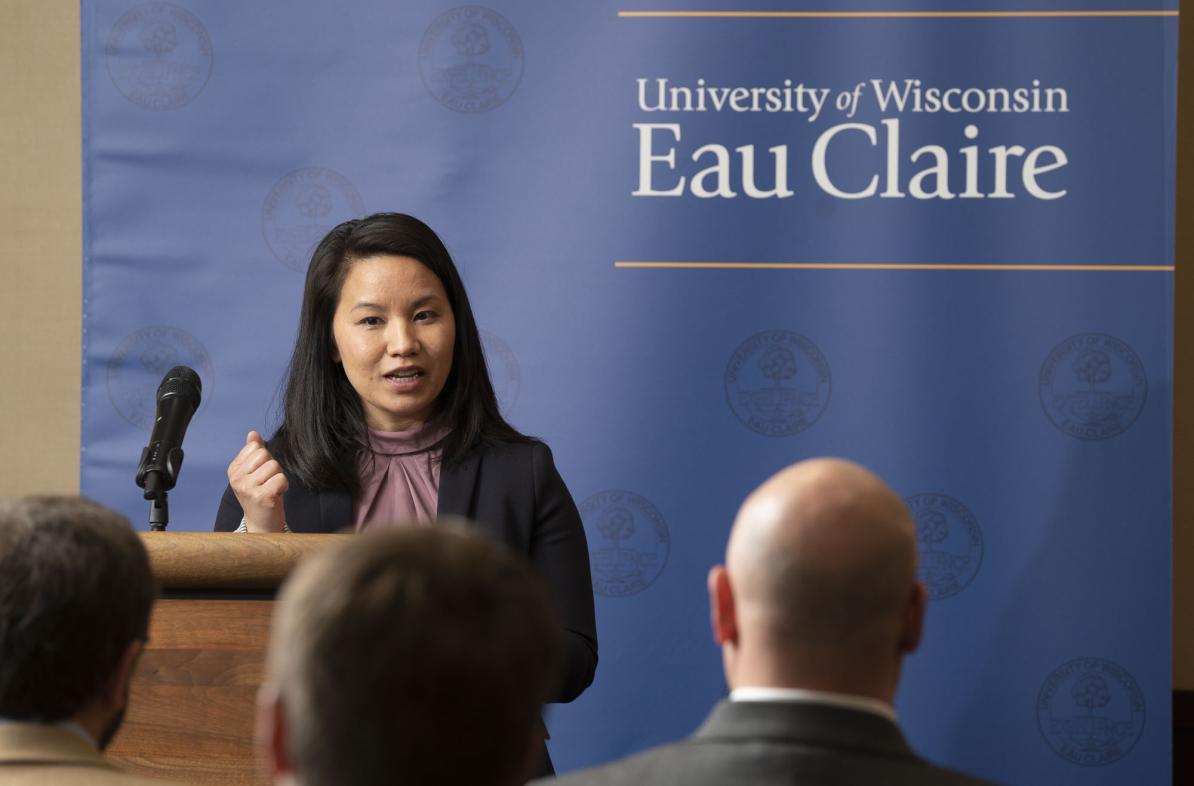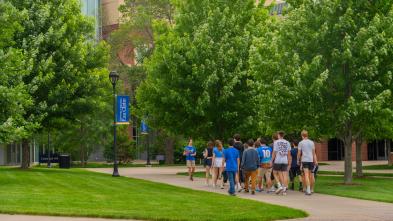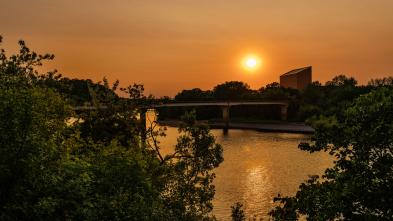
Sustainability boost for Sonnentag Center
Pablo Foundation, the University of Wisconsin-Eau Claire and its students, the city of Eau Claire and Xcel Energy are investing more than $12 million to reduce the carbon footprint in the Sonnentag Event Center and John and Carolyn Sonnentag Fieldhouse.
The announcement Thursday of the sustainability features in the facility to be built on the redeveloped brownfield site showcases the power of collaboration that is at the core of UW-Eau Claire’s 106-year-old legacy, says Chancellor James Schmidt.
“The city of Eau Claire and Xcel Energy have been steadfast partners and the Pablo Foundation is truly the wind beneath our wings,” Schmidt says. “Not only is their generosity powering the building, but it is giving us the courage and determination to continue to work aggressively to reduce our carbon footprint and to build new buildings that will not only serve our students but that will have a role in ensuring a healthy world for future generations.”
The Sonnentag Event Center and the John and Carolyn Sonnentag Fieldhouse will be in the County Materials Complex on Menomonie Street that also will include the Mayo Clinic Health System Diagnostic Imaging and Sports Medicine Center. Groundbreaking for the complex will be Monday, April 25.
Pablo Foundation is providing a total of $9.997 million toward the sustainability efforts with a $5 million grant, and the remainder of the money given in the form of a low-interest loan to be repaid over several years through energy savings.
The Pablo Foundation funds will be used for geothermal wells, piping, a heat exchanger and pumps, additional electrical capacity, a high-performance glazing system for windows, and additional wall and roof insulation.
Schmidt says Pablo Foundation founders had approached him to inquire about the ways UW-Eau Claire planned to reduce the carbon footprint in the County Materials Complex. Schmidt asked the foundation to “help us find a way to make the Sonnentag project as carbon neutral as possible.”
“Never did I imagine that their ‘help’ would translate into such a significant investment,” Schmidt says of the nearly $10 million contribution.
MaiVue Xiong, executive director of Pablo Foundation, explains the organization’s nearly $10 million contribution to sustainability efforts in the Sonnentag Event Center and John and Carolyn Sonnentag Fieldhouse. (Photo by Bill Hoepner)
Of the contribution, Pablo Foundation’s executive director, MaiVue Xiong, adds, “We are honored to be partners in this great project that will have the capacity to bring together those inside and outside our community in ways we’ve never seen before. We are especially honored to support the environmental sustainability infrastructure of the Sonnentag Event Center.
“True to our mission, this project prioritizes our planet, and it is our sincere hope that the carbon-reducing features of the Sonnentag Center will serve as a model, to be replicated again and again in our community, and even across the nation.”
The city of Eau Claire is contributing $1.5 million toward the project that aligns with the city’s Renewable Energy Action Plan (REAP) addressing how Eau Claire will meet its 100% renewable energy and carbon neutrality commitments by 2050.
“We are fortunate to have community stakeholders that trust and understand the work and investment that is necessary to instill change in all of us,” says Terry Weld, Eau Claire City Council president. “And in turn, help lead us to improved health, air and water quality, essential service resiliency and economic development within our community.”
UW-Eau Claire students provided $150,000 to the project last year and the Student Senate is considering a request for an additional $200,000 to support applications for Leadership in Energy and Environmental Design (LEED) certification and WELL Health-Safety Rating (HSR). The WELL HSR consists of features such as ongoing monitoring of air and water quality, managing mold and moisture, and cleaning and sanitization practices.
Students are passionate about sustainability and climate action, says Maddie Loeffler, director of UW-Eau Claire's Student Office of Sustainability. The features in the project will contribute to a more sustainable and climate-conscious university and community, she says, and will mobilize students to get involved.
“This isn’t the end of UW-Eau Claire’s bold moves to combat climate change, but it is a strong beginning and sets a great example for what can be present in future projects,” Loeffler says.
Dr. James Boulter, professor of chemistry and biochemistry, and public health and environmental studies, says Blugolds can take a class this fall, titled “Building Sustainability in the Academy,” that will use the complex's building process as a teaching tool.
“They will learn from our own architecture team and then watch as these principles are integrated during design and construction,” Boulter says. “They will become engaged in the process of the creation of one of western Wisconsin’s most advanced and sustainable buildings.”
Xcel Energy says the facility will be the first to participate in a new renewable energy program that will allow it to be powered with up to 100% carbon-free energy through a local solar resource.
In addition, Xcel Energy will assist in developing a pollinator habitat to support bees and butterflies in green spaces and near the utility corridor; donate five solar-powered charging park benches; and partner with the building’s architects and engineers to create charging stations for electronic vehicles.
Mark Stoering, president of Xcel Energy Michigan and Wisconsin, says the company always is looking to help strengthen communities and lead the transition to clean energy. He thanks the partners in the County Materials Complex project for their support and their collaborative efforts on sustainability.
“I often say that Eau Claire, our headquarter city for Xcel Energy Wisconsin and Michigan, is a model for the other 500 communities we serve in Wisconsin,” Stoering says.
The County Materials Complex will be the largest indoor event venue in northwestern Wisconsin. The 170,500-square-foot off-campus facility will contain a fieldhouse with a capacity of 5,000 people and be home to Blugold men’s and women’s basketball.
The total cost of the County Materials Complex will be $100.6 million that includes the $85.6 million multiuse facility and the $15 million Mayo Clinic Health System Diagnostic Imaging and Sports Medicine Center.
On April 6, Pablo Group announced plans to build a 128-suite SpringHill Suites by Marriott hotel adjacent to the County Materials Complex. The building, which will be located alongside the complex and the Chippewa River Trail along Menomonie Street, is scheduled to open in 2024.
Pablo Group also plans to build and operate a restaurant with a patio on the banks of the Chippewa River near the County Materials Complex.
County Material Complex sustainability highlights:
- Redevelopment of brownfield site.
- Removal of 80% of total suspended solids from storm water runoff.
- Green vehicle parking.
- (10) Electric vehicle charging stations (plan for more in future).
- Bicycle and pedestrian friendly site and facility.
- Heavy use of native plantings and non-irrigated landscape.
- Greater than 30% indoor water use reduction.
- Greater than 50% outdoor water use reduction.
- Greater than 75% diversion of construction waste from landfill anticipated.
- Enhanced sustainability goals of net-zero energy and net-zero carbon.
- Mechanical building system to include two hundred (200) vertical geothermal wells that utilize naturally occurring ground source heat, rather than producing heat through the combustion of fossil fuels, to heat and cool the building.
- Building will be fully electric and will not consume fossil fuels, thereby significantly reducing overall operational carbon emissions and dramatically increasing carbon offsets.
- LED lighting used throughout the facility.
- Building automation system that provides high level of electrical and mechanical building system control.
- Improved building envelope performance achieved with greater insulation, energy efficient wall systems, and high-performance window and door systems.
- Partnership program with Xcel Energy to provide 100% of facility’s power requirements from a local, offsite solar PV plant.
- Enhanced commissioning, building envelope commissioning and life cycle assessment aimed at improving building performance and understanding environmental impact.
- Monitoring based commissioning and metering of building systems to track performance, adjust, and improve over time.
- Pursuing LEED certification.
- Pursuing WELL Health Safety Rating focused on operational policies, maintenance protocols, and emergency plans to improve the health and well-being of facility occupants.
You may also like


